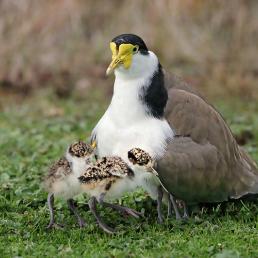

Join BirdNote tomorrow, November 30th!
Illustrator David Sibley and actor H. Jon Benjamin will face off in the bird illustration battle of the century during BirdNote's Year-end Celebration and Auction!
There’s a group of birds that lay their eggs underground — in geothermally heated burrows, or warm sands, or even mounds of organic material warmed by the heat of decomposition. These megapodes or mound-builders — like this Australian Brushturkey — are found in Australia, New Guinea, and nearby islands. The male builds a mound and adjusts the amount of material to maintain a constant temperature. After a long incubation, the eggs hatch and the chicks claw their way to the surface. They never know their parents, but emerge fully feathered and capable of flying and feeding themselves.
BirdNote®
Megapodes - Incubator Birds
Written by Gordon Orians
This is BirdNote.
[Ambient from ML188936 ]
Think of a bird sitting on its eggs, keeping them warm, waiting for them to hatch. Sounds familiar, right? But not all birds do this.
Some lay their eggs underground. In geothermally heated burrows … in warm sands … or even in huge mounds of organic material warmed by the heat of decomposition.
[ML188936 ]
These birds are called megapodes or mound-builders, and they look a bit like large chickens. There are about 20 different species, and they’re found in Australia, New Guinea, and nearby islands.
The male builds the mound, which may contain tons of organic matter. Periodically he’ll poke his beak in to check the temperature. Then he’ll adjust the amount of material to maintain the heat at a constant high level.
[ML188936 ]
Deep below the surface are the eggs. They’re larger than most and contain a higher proportion of yolk. After an unusually long incubation period, the eggs hatch and the chicks claw their way to the surface. They never know their parents. But the young megapodes are already fully feathered and capable of flying and feeding themselves.
As always, you can see photos and videos. Begin at BirdNote.org.
I’m Mary McCann. [ML188936 ]
If you ever miss a BirdNote, you can always get the latest episode. Just tell your smart speaker, “Play the podcast BirdNote.” Learn more on our website, BirdNote.org.
###
Bird sounds provided by The Macaulay Library of Natural Sounds at the Cornell Lab of Ornithology, Ithaca, New York. 188936 recorded by Cedar A Mathers-Winn.
BirdNote’s theme music was composed and played by Nancy Rumbel and John Kessler.
Producer: John Kessler
Executive Producer: Sallie Bodie
© 2017 Tune In to Nature.org June 2017/2021 July 2023
Narrator: Mary McCann
ID# megapode-01-2015-8-11 megapode-01



